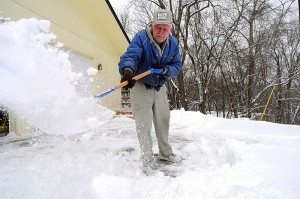We didn’t want to do it, but with more snow on the way, we offer our Johnson & Rohan Insurance Winter of 2014 – 2015 Snow Shoveling Tips:
The Basics
Snow shoveling can be compared to weight lifting, and in some cases, the aerobic aspect of this activity is similar to a workout on a treadmill! To help your body function on demand, consider the following …
- Be heart smart! Don’t eat or smoke before shoveling snow. Avoid caffeinated beverages. These are stimulants and may increase heart rate and cause blood vessels to constrict.
- If you experience pain of any kind, stop immediately and seek assistance.
- Pace yourself during shoveling activities. Take frequent breaks and drink plenty of water. Snow shoveling is strenuous work, and it is important to re-hydrate your body often.
- If the ground is icy or slick, spread sand or salt over the area to help create foot traction. Be aware that some areas may be uneven and could cause you to slip, trip, or fall.
Dress for Success!
- Consider the weather when choosing outerwear. Dress in layers. Wear clothing that is easy to move in.
- Wear a hat—a great deal of body heat is lost through the head.
- If it’s icy cold, consider breathing through a scarf, but don’t let it obstruct your view.
- Proper boots are essential for keeping feet warm and dry while appropriate soles provide traction. Good boots can help you maintain your balance!
- Choose gloves that will keep your hands warm, dry, and blister free—consider thicker gloves, which allow for a good grip on the shovel’s handle.
Select a Shovel that’s Right for You
Shovels are made from different materials and come in many shapes and sizes.
- Choose a shovel that is ergonomically correct—a shovel with a curved handle. Many hardware stores and home centers stock ergonomically designed snow shovels. These shovels help you to keep your back straighter reducing spinal stress.
- Consider a shovel with a plastic blade instead of metal—plastic is lightweight—isn’t the snow heavy enough?
- Sometimes a smaller blade is better. You will not be able to shovel as much snow per shovel load, but the load will weigh less, which puts less strain on the spine.
- Get a shovel made to push snow. It is far easier to push snow than to lift it. There are shovels made expressly for pushing snow. See what is available at your hardware or home center store.
Once you have your shovel, you might want to consider spraying a bit of silicon lubricant on the blade. This can help keep the snow from sticking to the shovel. The snow will slide off the shovel blade.
Technique. Technique. Technique.
- Warm muscles work better. So take some time to stretch to prepare your body for activity.
- Just like with a golf club, hand placement on the shovel handle is very important! Don’t put your hands (grip) close to one another. Create some distance between the hands. This will give you more leverage and make it easier to lift snow.
- Think about good posture and maintaining the natural curve of your spine.
- Address your task directly. Stand with your feet about shoulder width apart to maintain balance. Try to keep the shovel close to your body. Bend at the knees—not the waist or back. Tighten your stomach muscles as you lift the snow. Lift with your legs—not your back. Do not twist your body. Dump the snow in front of you. If you need to move the snow to the side, move your feet—do not twist!According to the American Academy of Orthopaedic Surgeons, “If you must lift the snow, lift it properly. Squat with your legs apart, knees bent and back straight. Lift with your legs. Do not bend at the waist. Scoop small amounts of snow into the shovel and walk to where you want to dump it. Holding a shovelful of snow with your arms outstretched puts too much weight on your spine. Never remove deep snow all at once; do it piecemeal. Shovel an inch or two; then take another inch off. Rest and repeat if necessary.”
- Don’t throw snow over your shoulder! Go forward with the snow.
- Fresh snow is lighter in weight—so clear snow as soon as it has fallen. Snow becomes dense as it compacts on the ground. Wet snow is very heavy. One shovelful can weigh 20 pounds or more!
- Pace yourself. Take frequent breaks to stretch your back and extremities.
Snowblowers
A snowblower is a terrific piece of machinery, but if it’s not used correctly, you can strain or injure your back. Snowblowers are designed to remove snow at a particular rate of speed. Pushing or forcing the equipment to go faster is defeating its purpose—to do the work for you!
Community Involvement
Not everyone is able to shovel snow or operate a snowblower. Consider the disabled and some in the senior population. Fortunately, many communities across the US have organized volunteers to help people who need assistance during the winter season.

